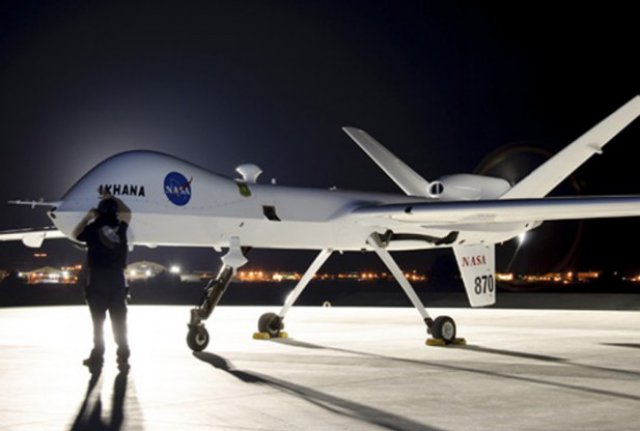Ikhana, NASA’s remotely piloted, unmanned aircraft system (UAS), will be used December 4 to capture video of the Orion crew module Exploration Flight Test 1 (EFT-1) as the module descends through the atmosphere into the Pacific Ocean.
The aircraft’s camera, mounted on the plane’s underside, will generate a live video feed of the descent. Ikhana was acquired by NASA in November 2006 to support Earth science missions and advanced aeronautical technology development.
While Ikhana loiters at 27,000 feet altitude, the infrared camera will detect the capsule. Once the camera has located and acquired the Orion module, the camera operator will switch to an optical camera that will observe Orion’s descent through parachute deployment and splashdown.
The pilot will fly the UAS from the Ikhana ground control station located at NASA’s Armstrong Flight Research Center on Edwards Air Force Base, California, while a sensor operator will point the optical camera for visual sighting of the module.
Video will be sent real-time via satellite to NASA TV for live broadcast of the module’s descent and recovery. The aircraft will depart Armstrong hours before EFT-1 launch to arrive at the planned reentry and splashdown area ahead of Orion.
Ikhana’s versatility allows it to fly for more than 20 hours at a time and reach altitudes above 40,000 feet. The aircraft has a wingspan of 66 feet, and it is 36 feet long.
Background
NASA uses the Ikhana aircraft as an airborne science test bed, and to develop capabilities and technologies to improve the utility of unmanned aircraft systems. The name Ikhana originates from Native American Choctaw language meaning intelligent, conscious or aware.
In 2012, NASA also used the Ikhana to test an Automatic Dependent Surveillance-Broadcast device. ADS-B is an aircraft tracking technology that determines a plane’s position using satellite navigation. The Federal Aviation Administration will be requiring all airplanes operating in U.S. airspace to have this device by January 2020.
Ikhana is currently using ADS-B and other technologies in flight tests of Autonomous Collision Avoidance System for UAS (ACAS-Xu). These tests will provide decision makers with information about safe approaches that will advance autonomous collision avoidance and self-separation of aircraft.
Built by General Atomics Aeronautical Systems, Inc., Ikhana is a demilitarized MQ-9 Predator B owned and operated by the agency with technical support from the Air Force’s Medium Altitude UAS Division and the Nevada Air National Guard.
Missions
The Ikhana project concluded its deployment over the Hawaiian Islands in August 2014. On that mission, new aircraft systems were tested that may allow the plane to fly future science missions into the Arctic Circle region as part of NASA’s commitment to improving understanding of Earth and its resources.
Ikhana was also used in the Western States Fire Mission from 2007 – 2009 demonstrating improved wildfire imaging and mapping capabilities of a sophisticated sensor and real-time data communications equipment.
After years of laboratory development and test, large-scale dynamic field test of a NASA-patented fiber optic-based sensor technology began in 2008 when the technology was flown on the Ikhana to measure real-time changes in wing shape during flight. The effort represented one of the first comprehensive flight validations of fiber optic sensor technology.
Source: Red Orbit

